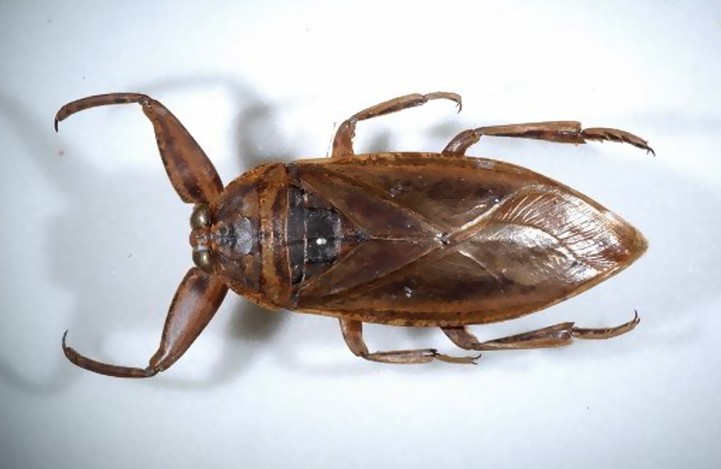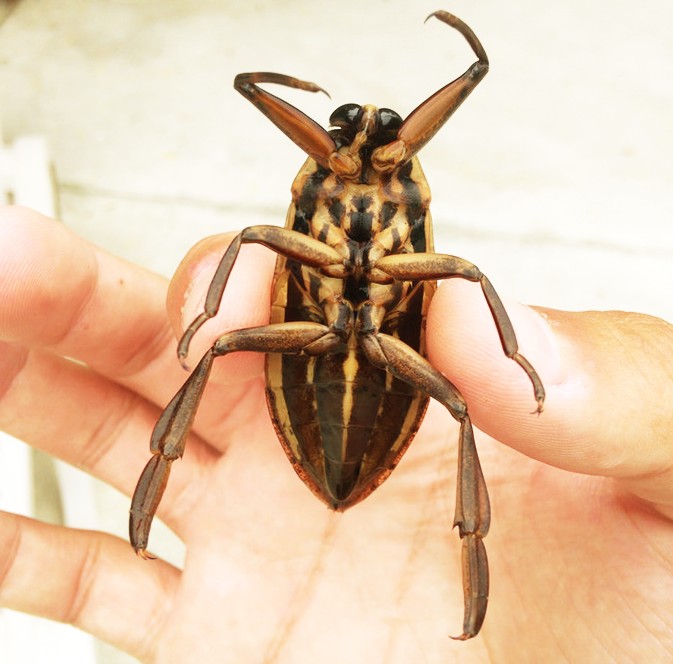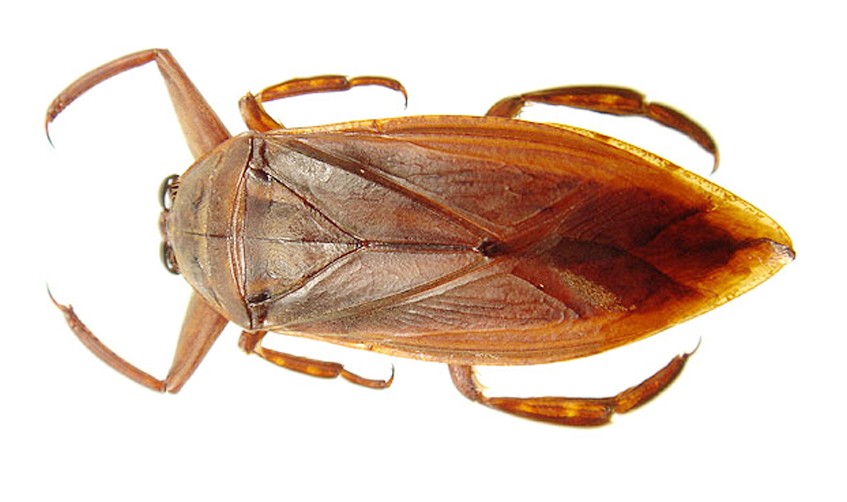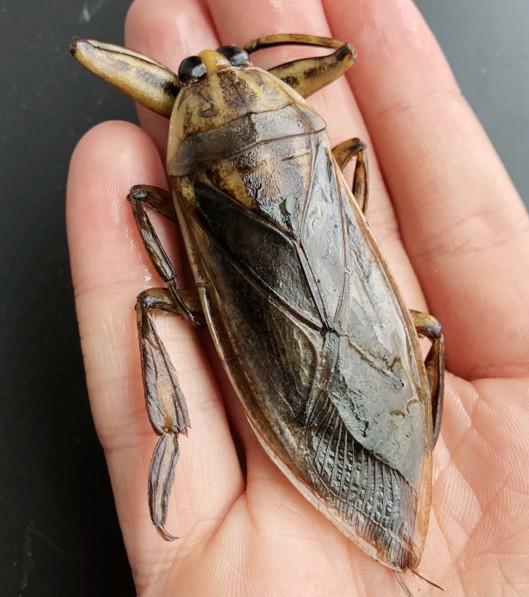Water Bug

Picture of a Water bug
The term water bug should not give you a churning stomach because it is not as dangerous as you imagine. Waterbug is just an insect found in water. Though a few misconceptions surround this creature, we will tell you everything you are supposed to know about this insect in this write-up. Without much ado, let’s learn more information about this bug.
What is a Water bug?
Water bug is an aquatic (found in water) insect belonging to the Hemiptera family. Other types of water bugs are the pond skater, water spider, and water strider which belong to the Gerridae family.
In reality, the term water bug refers to larger cockroaches that are widespread and can be any of:
- The Oriental cockroach
- The American cockroach
- The palmetto bug otherwise referred to as the Florida woods cockroach.
These three species are larger when compared to the German cockroach that is common in our homes.
What does a water bug look like?

Water bugs look like cockroaches and can easily be mistaken for one. However, their primary abode is water, though they also move around on land. Like cockroaches, they are insects.
Water bugs grow up to around one and a half inches in length. They are classified into two major groups: normal size and giant size. The giant water bugs grow up to 2-2½ inches long, though some have been found to be up to 4 inches long. They come in colors ranging from tan to dark brown and have oval-shaped bodies.
Identification
Water bugs are brownish (tan) or large blackish bugs. Their flying wings are covered by a hard outer shell otherwise known as the exoskeleton. They make use of their two front legs when hunting their prey, using the legs like pincers in the process. Though they look like cockroaches, they are a bit different in many ways.
Water bug vs. Cockroach
The first impression you get when you see a water bug is to think it is a cockroach. Well, you will not be entirely correct to think so. There is much dissimilarity between these two insects. Let’s quickly run through those dissimilarities:

- Size: Water bugs are larger than cockroaches. While water bugs can be up to 2 inches in length, cockroaches are usually around 1-1½ inches long.
- Eating habits: Water bugs mostly hunt and eat insects, tadpoles, larvae and eggs, crustaceans, etc. Cockroaches, on the other hand, are scavengers and do not hunt. Instead, they eat just anything, especially from the garbage.
- Habitat: While cockroaches are land insects found mostly in the homes, water bugs are primarily found around waters (though they occasionally come on land).
- Bite risk: Water bugs are a bit temperamental and bite people with their proboscis. However, cockroaches are shy and go into hiding when they see people or when lights are turned on. They are not known to bite people.
- Pest determination: Water bugs are not really described as pests because they feed on other insects. But cockroaches are pests with the tendency to cause a lot of health-related problems.
Do Water bugs Bite?
Yes. Water bugs are sometimes referred to as “toe-biters” because of their precision in biting the toes of people who swim in the water where they reside and threaten them. Their bites can be quite painful, and there have been a few occasions of certain people developing some allergic reactions when bitten by them.
What do Water bugs Eat?

Picture of a water bug feeding on fish
- Water bugs feed on a variety of insects and other aquatic creatures.
- Larvae and eggs: they eat larvae and eggs of frogs, mosquitoes and other wildlife, which they find close to the water.
- Tadpoles: they also feed on tadpoles (young frogs).
- Crustaceans: in addition, water bugs eat crabs and other related aquatic animals.
- Fish: Bluegill and guppies also form a part of the water bug’s diet.
- Insects: The water bug equally relishes ants, crickets and other insects.
- Amphibians: The bugs also add frogs and lizards to their menu when available.
Do water bugs fly?
Several species of cockroaches are endowed with wings for flying. Water bugs are just one of the species of cockroaches that can fly and can fly between bodies of water (though not all species of cockroaches can fly.
Water bugs in Pool – How to prevent them
Though water bugs are naturally born on the bank of rivers and ponds and do not constitute a nuisance to your home, you can do some things to check their population. Some of the ways you do this include:
Spray: If you live close to a river or pond, spray around the window sills and foundation of the house with insecticides.
Clear all standing water: You need to remove from the surroundings all pet dishes and buckets filled with water.
Diseases they can spread
Water bugs are not known to harbor any disease that can infect man. The only distress is the bite they deliver, which can be really painful. Sometimes, though, their shed skins can cause an allergic reaction to some people.
How to Get Rid of Water bugs?
- Roach baits: they are quite convenient and easy to apply. They are of different forms, but you can make use of the roach gels and roach motels. Simply apply them under cabinets, along baseboards and walls.
- Boric acid and borax: Apply a thin layer of the powder or dust in the area where you commonly find the water bugs, on basements, around window sills, etc. and that solves the problem. Avoid applying them in heaps as the bugs would simply not climb over the heaps.
- Roach spray: Get one of the reliable sprays from your local mega store and apply them with the aid of a dedicated sprayer. It is preferable to use the one that contains cypermethrin as its active ingredient. If there are water bugs in your home, you can also kill them physically to eliminate them.
Water bug Bite Treatment
Water bugs do not cause diseases to man, but their bites can be a bit painful and require some first aid treatment. In the event of a bite, the following can help:
Wash the bitten area with soap and water. Rub the soap repeatedly over the affected area with a thick lather soap. Allow the soap to stay for a few seconds to a few minutes to eliminate itching and the possibility of your skin getting infected.
Use some home remedies. These include:
- Aloe Vera gel comes with antifungal and antibacterial properties which help in averting secondary infections.
Apply ice packs to minimize swelling - Dip a cotton ball in lemon juice and apply it sparingly over the area to lessen itchiness.
- Make a paste of water and baking soda and then apply it on the bite area. Let it stay for about an hour before rinsing off with cold water.
- Apply calamine lotion to provide a soothing effect and heal the skin.
- Take some anti-inflammatory/analgesic drugs like ibuprofen or aspirin, to kill the pain.
- Apply over-the-counter steroidal creams such as 1% hydrocortisone or cortisone, to minimize inflammation and itching.
- Apply topical antihistamines or use oral ones to reduce allergic reactions.
Interesting Water Bug Facts
- Water bugs go through a gradual metamorphosis. They pass through three stages – eggs, nymph, and adults.
- They easily go on the defensive and bite humans when they feel threatened.
- Water bugs are further classified into Giant water bug, Water boatman, Water scorpion, Water strider, and backswimmer.
- The Giant water bug is the world’s largest bug
- They have a lifespan of up to one year
- While giant water bugs grow up to 2-2½ inches long, the ordinary water bug grows up to 1½ inches in length.
- Though the female bug aggressively protects her eggs, she can turn around to feed on them when there is no food.
- The bugs can overlap their wings to make an ‘X’ shape.
- They intelligently monitor flood conditions, avoiding being caught in a flood and returning after the flood is over.
- They skin their beaks into their prey and inject them with venom when they want to kill them for food.
- Since water bugs enjoy light, they get out of the water at night in order to fly around and have a feel of light.
- Water bugs are able to escape their predators using their natural skin colors which camouflages with several surrounding plants. They also pretend death to escape from their predators.
- Mating in water bugs can take up to a few hours to complete. The male and female continue their mating for such a long time until the male’s back is covered with eggs. Just one process can involve up to 150 eggs.
Pictures
Take a look at some of the pictures of water bugs:


Conclusion
Water bug is not really seen as a pest since it does not cause any disease to humans or disturb our natural habitat. They are even beneficial to man by helping him get rid of some insects such as mosquitoes thereby preventing malaria and economic waste.
However, if you are bitten by water bugs, simply apply the home remedies we mentioned above and you will be better. We have equally listed some of the methods you could use to get rid of the bugs should there be any need to do so. Remember to leave a question in our comment section if you still have any concerns.
